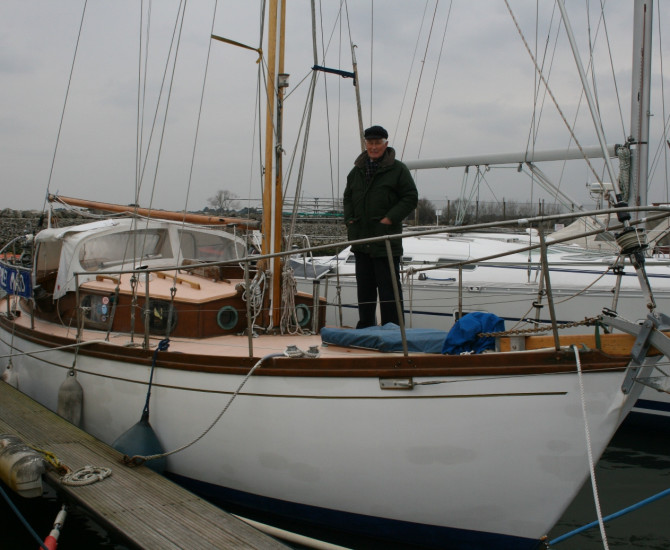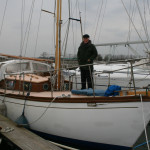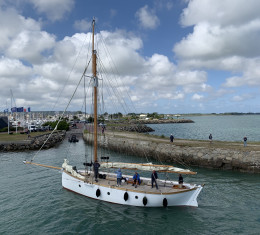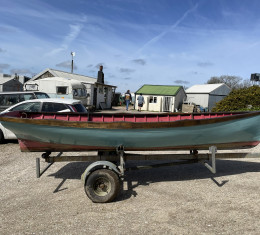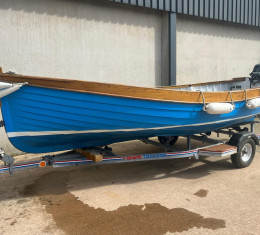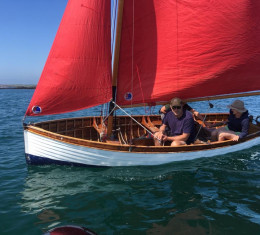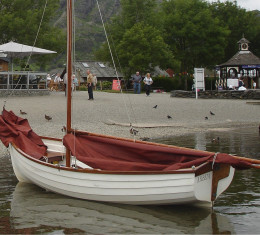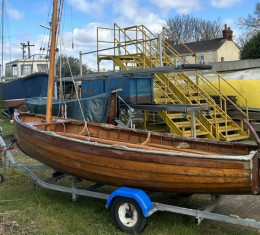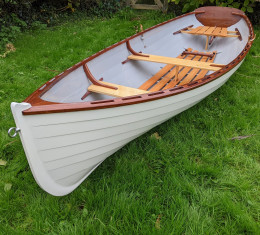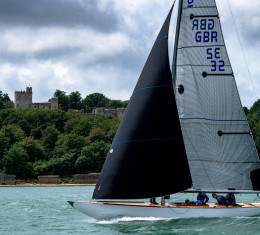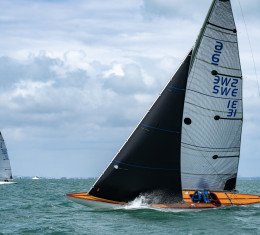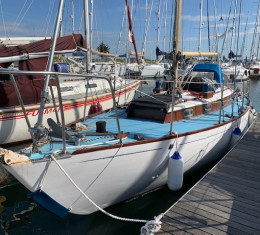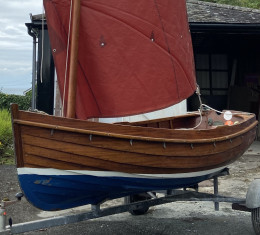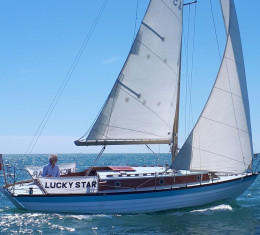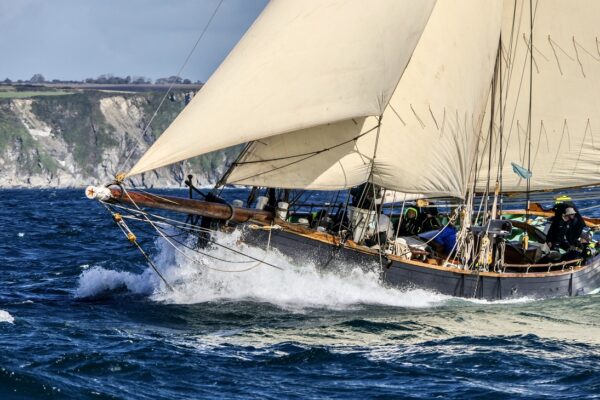Sailing yachts
Full specification
Wooden ships comments on this 10 ton Hillyard built by Hillyards of Littlehampton in 1971.
David Hillyard was the most successful boat builder in UK until the arrival of grp and mass boat construction.
Starting in 1920’s when yachting was becoming popular in the recovery period after the Great War, David Hillyard built little 2 ½ tonners of around 22’ – 24’. They were good little sea-boats, they were cheap and his reputation was established.
He developed his signature design after 1945 with the 9 tonner. This was a conventional long keeled yacht hull design but with a centre-cock-pit which allowed for an aft cabin in addition to the saloon cabin and the fore cabin.
A 30’ yacht with 2 separate sleeping cabins outside the saloon was a revolutionary design. Add a big deep centre-cockpit and success was assured in the growing market for family sailing.
He introduced the bigger 36’ 12 tonner (all measurements in Thames Tonnage) with a few variations on the theme and there were several much bigger boats up to 50’.
In a search for more volume while still keeping the length within cost-effective limits given the rising price of moorings, he introduced the hard-chine design with a transom stern. He also gave some of his yachts steel plate bilge keels allowing them to sit upright on the beach.
David Hillyard was a very canny builder. He adopted some build methods which were considered unconventional by the old school builders and was never afraid to introduce methods which would save money without compromising strength and safety. Unconventional he may have been but his designs and construction have stood the test of time and by far the majority of his yachts are still afloat and sailing today and in many corners of the world.
Many are the stories of his particular ways, some true, some undoubtedly mythical. He was a devout Chapel man, his boats were always supplied to the new owners with a Bible in the locker and over many years he has earned the respect of many devoted owners.
I suspect that the design of this yacht started as the standard 32’ 9 tonner. However David Hillyard was not averse to fitting in with the requirements of individual owners and in this case he appears to have spaced out the forward moulds and given the stem more forward rake. The result is a slightly longer boat with slightly sleeker lines and a little more volume which is noticeable especially in the interior.
The yacht was bought by the present owner in 1983 and he became the third only owner.
He did a refit in the first season and since then has cruised many thousands of miles around UK and European costs.
20 years ago he took 10 months out of the office and crossed the Atlantic.
The yacht has been methodically and carefully kept up to date without making any great changes or loosing any of the character these wonderful yachts have. Sadly, owners get older before their yachts and only advancing years dictate finally hanging up his oil-skins.
The yacht is presented in tidy condition, no obvious weaknesses, fully equipped for cruising and ready to sail away.
In recognition of the current difficult economic climate we have persuaded the owner that he must accept a lower price than the real value of this fine yacht and in August 2013 he agreed. He would rather see her sailing and a new owner enjoying her as he has done than sitting in on her berth unused.
Construction.
Planked in iroko. Hillyards used a number of timbers over the years to plank their boats but the later boats like this were all planked in iroko, durable and stable African hardwood obtainable in long lengths of uniform quality and the most popular hardwood amongst modern wooden boat builders. Although difficult to check, she is almost certainly planked with full length planks.
David Hillyard’s method of framing was typical of the man. He cut oak to a standard size, about 2” x ¾” and steam bent these into place, secured with copper nails and roves. However every 4th timber was doubled by laying one on top of the other to give extra strength using the same stock timbre to create frames which were 2” x 1 ½”.
The back-bone is oak.
A long external 3 ½ ton iron ballast keel is incorporated into the keel secured with galvanised mild steel keel bolts. In a yacht of this size there will be about a dozen bolts, all approx ¾” diam.
Most Hillyards carry a considerable amount of internal ballast in the form of iron pigs, in this case approx 1 ½ tons which gives an approximate 40% ballast ratio.
Approx 2005 all internal ballast removed from the yacht, shot blasted, painted with a 2-pot epoxy black paint and replaced giving a clean bilge free of the usual Hillyard rust red water.
The floors are all oak through the length of the back-bone.
Steering is by a wheel in the center-cock-pit with cables round the port side back to a galvanised steel quadrant on top of the vertical galvanised steel rudder stock.
The stock works in a vertical galvanised steel tube through the horn timber. This stock tube shows none of the usual corrosion where it passes through the horn timber.
The rudder blade is timber.
The heel is carried in a galvanised steel shoe on the after end of the keel.
The cables were replaced in the recent past with flexible steel wire cables and the turning block reinforced.
Emergency tiller facility by removing a bronze plug on the aft deck and dropping the emergency tiller stock onto the quadrant below. This can be accomplished in very quick time.
The quadrant and cables are all easily accessed in the aft cabin under the aft deck.
Nothing on a Hillyard is covered up or boxed in. Easy access is made to every corner.
The deck is in marine ply and sheathed, probably glass cloth and resin, and painted to give a clean, uncluttered and minimum maintenance surface.
A gold caveat line is cut round the sheer strake.
A substantial rubbing strake with toe rail above all in iroko a finished bright in Sikkens oil for ease of application.
Pushpit, pulpit, stanchions and rail in satin finished stainless steel tube.
All fitted new some years ago
The superstructure is divided in the forward coach-roof and after coach-roof with the cock-pit coamings continuous between the two. The forward coach-roof extends forward up to the mast.
The coamings are in iroko finished bright like the toe rails.
2 bronze opening ports in the forward coaming.
Fixed Perspex oval windows in the saloon.
Opening Perspex windows in the aft cabin using the Hillyard patent method.
The coach-roof tops are built in ply, sheathed and painted like the deck.
Varnished grab rails on both.
Dorade vents on the fwd roof.
The life raft stowed on varnished runners on the after roof.
Pair of massive galvanised bitts on the fore deck to take mooring warps.
Heavy galvanised steel Sampson post on the aft deck.
Galvanised stem-head fitting with anchor chain rollers each side allowing for the anchors to self-stow and fore stay attachment point. Fitting newly galvanised
Heavy galvanised steel bowsprit heel fitting.
Massive original manual windlass with warping drum and chain gipsy.
Spray-hood over the cock-pit incorporated in a complete cock-pit tent removeable in 2 parts with big front windows on a galvanised folding pram-hood frame. Side flap entrances.
Bermudian cutter rig.
The rig was changed in present ownership from the original masthead/stemhead sloop to the present cutter rig by the simple addition of a fixed varnished spruce bowsprit. The owner says this change has not affected the balance of the yacht and has allowed her to carry more sail with notably beneficial result on her sailing performance.
Original rectangular box section varnished spruce mast stepped in a wooden tabernacle on deck against the forward face of the coach-roof.
Single spreaders.
Standing back-stay to the horn timber
Masthead/stemhead inner forestay.
Masthead/end of bowsprit outer fore stay.
Twin lowers to the spreaders, masthead cap shrouds round the spreaders.
Hangers on the spreaders.
Guys and bob-stay to the bowsprit.
All rigging is stainless steel wire with swaged terminals replaced in present ownership.
Galvanised rigging screws to the original internal galvanised mild steel chain plates.
Varnished pole with bronze end fittings runs on a bronze track up the forward face of the mast.
Varnished spruce boom with original bronze roller furling gear.
The boom now converted to slab reefing.
Double tailed mainsheet on varnished wooden blocks anchored to the after end of the coach-roof. Tails led in to cleats on the after coach-roof deck inside the cock-pit cover
Bronze mainsail track.
Furlex roller furling gear on the jib
Seafurl roller furling gear on the staysail.
Sails
Mainsail
150% Genoa on the Furlex gear, masthead to the end of the bowsprit.
Staysail on Seafurl roller furling gear, masthead to stemhead
Hi-cut yankee jib.
Storm jib
Machinery.
Perkins 55hp 4-cyl naturally aspirated fresh water cooled diesel engine.
Engine fitted in spring of 2005. This was a totally recon unit supplied by Winchester Marine and fitted by Poole marine engineers.
It looks to be in as new condition.
Centre-line installation with single lever controlled hydraulic gearbox.
Conventional centre-line shaft drive with Aquadrive to take the thrust and any shaft vibration Aquadrive fitted in present ownership
Tanks
Fuel 36 galls in a steel tank under the stbd side deck in way of the cock-pit. Deck filler
Water 36galls carried in a steel tank under the port side deck in way of the cock-pit. Deck filler
Electrics.
2 x 12v 80 amp/hr batteries on 12v circuits. The two batteries are in boxes in the engine compartment and easily accessed.
Engine alternator.
Accommodation. 6 berths.
Forward cabin with V berths. Present owners use the fore cabin as a heads and stowage.
Fore hatch over. Stowage under the berths.
A sea toilet is installed under the after end of the stbd berth with a fold-up lid over.
Passage and bulkhead doorway to the saloon cabin.
Lockers to port and stbd. over the trotter berths at fwd end of the settee berths.
Taylors diesel heater on the port side passage bulkhead. Fuel tank in the locker above.
Port and stbd settee berths. Stowage below the settees, fold-down back rests to stowage behind and shelves above.
Varnished mahogany drop leaf table.
Chart desk in the after stbd corner with drawers and lockers below, nav instruments above.
Galley in the after port corner with cooker and sink against the after bulkhead and a small work surface under the side deck.
Plastimo 2 burner, grill and oven gas cooker with good fiddle rails.
Stainless steel sink drains overboard by a hull fitting just above the wl with sea-cock.
Good galley stowage under and above.
Stbd off-set step up to the cock-pit. Usual Hillyard sliding door.
Large, deep and very safe centre cock-pit. Seat lockers each side with tanks visible under the side decks.
Harwood sole lifts in 3 sections to give total all round access to the engine below. Step down in and sit alongside the engine!
Traditional wheel on the fwd bulkhead to port. Wide coach-roof deck surface in front carries the main steering compass. Secondary compass on the bulkhead.
Spray-hood and integral cock-pit canopy on fold flat, galvanised pram-hood frame with zip-up side flap entrances. Large front Perspex windows.
Stbd offset doorway and step down to the aft cabin. Generous port and stbd berths with good drawers below.
A large hanging locker under the side deck alongside the entrance fitted with shelves inside.
Originally a sea toilet was fitted in the forward port corner, now removed and fitted with a shelf carrying a stainless steel hand basin and a 12v freezer box below.
Usual Hillyard dark varnished mahogany joinery being a combination of mahogany faced marine ply and a slightly lighter solid mahogany, all varnished with varnished sole boards and coamings above. White painted hull interior faces, white painted cabin deckheads
Head-room.
Saloon cabin 6′
Aft cabin 5’9”
Fore cabin under deck 5’
Under fore hatch 5’10”
Water
Pressurised water supply to the galley and the aft cabin hand basin, mixer taps at both.
Hot water from a calorifier tank heated by the engine cooling water.
Manual sea water pump at the galley.
Inventory.
Navigation equipment.
Sestral steering compass in front of the helm
Ritchie secondary small steering compass on the cock-pit bulkhead.
Hand bearing compass
Garmin 128 GPS
Furuno radar
Stowe wind speed and direction
Raymarine 54E VHF radio
Hand held VHF radio
Navtex Pro Target weatherfax
Hydrovane self steering
Wheel auto-pilot
Clock and barometer
Safety gear
4 man life raft (in date)
Life jackets
Life buoy
Fire extinguishers
Flares
Life lines
Deck gear
Boat hook
Varnished mahogany boarding ladder
Folding boat bicycle
Ground tackle
CQR bower anchor
Approx 15 fthms chain
Fisherman anchor with warp
Kewdge anchor with warp.
12v windlass with manual over-ride.
Disclaimer:
These particulars have been prepared in good faith from information provided by the Vendors and are intended as a guide, Wooden Ships cannot guarantee or warrant the accuracy of this information nor warrant the condition of the vessel. The Purchaser should instruct his agent or surveyor to validate all details as necessary and satisfy himself with the condition of the vessel and its equipment.
Wooden Ships classic yachts brokers have an extensive database of boats for sale. With a wide range of sailboats, classic yachts, motor yachts and small classic boats, Wooden Ships has one of the largest selections of traditional wooden boats and yachts for sale in the UK.
Disclaimer:
These particulars have been prepared in good faith from information provided by the Vendors and are intended as a guide, Wooden Ships cannot guarantee or warrant the accuracy of this information nor warrant the condition of the vessel. The Purchaser should instruct his agent or surveyor to validate all details as necessary and satisfy himself with the condition of the vessel and its equipment.

